
Francisco de Zurbaran Painting Reproductions 1 of 2
1598-1664
Spanish Baroque Painter
Francisco Zurbarán (November 7, 1598 - August 27, 1664), was a Spanish painter, born at Fuente de Cantos in Extremadura. His father was Luis Zurbarán, a country labourer; his mother, Isabel Marquet.
In childhood he set about imitating objects with charcoal. His father sent him, still young, to the school of Juan de Roelas in Seville. Zurbarán soon became the best pupil in the studio of Roelas, surpassing the master himself. Even though Seville was full of able painters, he left with a solid reputation.
Style
He may have had here the opportunity of copying some of the paintings of Michelangelo da Caravaggio; at any rate, he gained the name of the Spanish Caravaggio, owing to the forcible, realistic style in which he excelled. He constantly painted direct from nature, following but occasionally improving on his model; and he made great use of the lay-figure in the study of draperies, in which he was peculiarly proficient. He had a special gift for white draperies; as a consequence, the houses of the white-robed Carthusians are abundant in his paintings. To these rigid methods, Zurbarán is said to have adhered throughout his career, which was prosperous, wholly confined to Spain, and varied by few incidents beyond those of his daily labour. His subjects were mostly severe and ascetic religious vigils, the spirit chastising the flesh into subjection, the compositions seldom thronged and often reduced to a single figure. The style is more reserved and chastened than Caravaggio's, the tone of color often quite bluish. Exceptional effects are attained by the precisely finished foregrounds, massed out largely in light and shade.
Later life
While in Seville, Zurbarán married Leonor de Jordera, by whom he had several children. Towards 1630 he was appointed painter to Philip IV; and there is a story that on one occasion the sovereign laid his hand on the artist's shoulder, saying "Painter to the king, king of painters." After 1640 his austere, harsh, hard edged style was unfavorably compared to the sentimental religiosity of Murillo and Zurbarán’s reputation declined. It was only in 1658, late in Zurbarán’s life that he moved to Madrid in search of work and renewed his contact with Velazquez. Zurbarán died in poverty and obscurity.
Artistic Legacy
In 1627 he painted the great altarpiece of St. Thomas Aquinas, now in the Seville museum; it was executed for the church of the college of that saint there. This is Zurbarán's largest composition, containing figures of Christ, the Madonna, various saints, Charles V with knights, and Archbishop Deza (founder of the college) with monks and servitors, all the principal personages being more than life-size. It had been preceded by numerous pictures of the screen of St. Peter Nolasco in the cathedral.
In Santa Maria de Guadalupe he painted various large pictures, eight of which relate to the history of St. Jerome; and in the church of Saint Paul, Seville, a famous figure of the Crucified Saviour, in grisaille, creating an illusion of marble. In 1633 he finished the paintings of the high altar of the Carthusians in Jerez. In the palace of Buenretiro, Madrid are four large canvases representing the Labours of Hercules, an unusual instance of non-Christian subjects from the hand of Zurbarán. A fine example of his work is in the National Gallery, London: a whole-length, life-sized figure of a kneeling Franciscan holding a skull. It seems probable that another picture in the same gallery, the Dead Roland, which used to be ascribed to Diego Velázquez, is really by Zurbarán. His principal scholars, whose style has as much affinity to Ribera as to Caravaggio, were Bernabe de Ayala and the brothers Polanco.
In childhood he set about imitating objects with charcoal. His father sent him, still young, to the school of Juan de Roelas in Seville. Zurbarán soon became the best pupil in the studio of Roelas, surpassing the master himself. Even though Seville was full of able painters, he left with a solid reputation.
Style
He may have had here the opportunity of copying some of the paintings of Michelangelo da Caravaggio; at any rate, he gained the name of the Spanish Caravaggio, owing to the forcible, realistic style in which he excelled. He constantly painted direct from nature, following but occasionally improving on his model; and he made great use of the lay-figure in the study of draperies, in which he was peculiarly proficient. He had a special gift for white draperies; as a consequence, the houses of the white-robed Carthusians are abundant in his paintings. To these rigid methods, Zurbarán is said to have adhered throughout his career, which was prosperous, wholly confined to Spain, and varied by few incidents beyond those of his daily labour. His subjects were mostly severe and ascetic religious vigils, the spirit chastising the flesh into subjection, the compositions seldom thronged and often reduced to a single figure. The style is more reserved and chastened than Caravaggio's, the tone of color often quite bluish. Exceptional effects are attained by the precisely finished foregrounds, massed out largely in light and shade.
Later life
While in Seville, Zurbarán married Leonor de Jordera, by whom he had several children. Towards 1630 he was appointed painter to Philip IV; and there is a story that on one occasion the sovereign laid his hand on the artist's shoulder, saying "Painter to the king, king of painters." After 1640 his austere, harsh, hard edged style was unfavorably compared to the sentimental religiosity of Murillo and Zurbarán’s reputation declined. It was only in 1658, late in Zurbarán’s life that he moved to Madrid in search of work and renewed his contact with Velazquez. Zurbarán died in poverty and obscurity.
Artistic Legacy
In 1627 he painted the great altarpiece of St. Thomas Aquinas, now in the Seville museum; it was executed for the church of the college of that saint there. This is Zurbarán's largest composition, containing figures of Christ, the Madonna, various saints, Charles V with knights, and Archbishop Deza (founder of the college) with monks and servitors, all the principal personages being more than life-size. It had been preceded by numerous pictures of the screen of St. Peter Nolasco in the cathedral.
In Santa Maria de Guadalupe he painted various large pictures, eight of which relate to the history of St. Jerome; and in the church of Saint Paul, Seville, a famous figure of the Crucified Saviour, in grisaille, creating an illusion of marble. In 1633 he finished the paintings of the high altar of the Carthusians in Jerez. In the palace of Buenretiro, Madrid are four large canvases representing the Labours of Hercules, an unusual instance of non-Christian subjects from the hand of Zurbarán. A fine example of his work is in the National Gallery, London: a whole-length, life-sized figure of a kneeling Franciscan holding a skull. It seems probable that another picture in the same gallery, the Dead Roland, which used to be ascribed to Diego Velázquez, is really by Zurbarán. His principal scholars, whose style has as much affinity to Ribera as to Caravaggio, were Bernabe de Ayala and the brothers Polanco.
43 Zurbaran Paintings
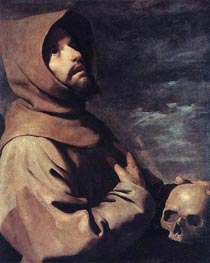
Saint Francis in Ecstasy c.1660
Oil Painting
$1064
$1064
Canvas Print
$87.32
$87.32
SKU: ZUR-883
Francisco de Zurbaran
Original Size: 65 x 53 cm
Alte Pinakothek, Munich, Germany
Francisco de Zurbaran
Original Size: 65 x 53 cm
Alte Pinakothek, Munich, Germany
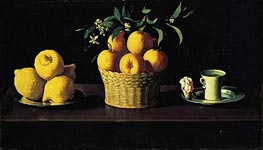
Still Life with Oranges, Lemons and Rose 1633
Oil Painting
$1328
$1328
Canvas Print
$72.89
$72.89
SKU: ZUR-884
Francisco de Zurbaran
Original Size: 62.2 x 109.5 cm
Norton Simon Museum of Art, Pasadena, USA
Francisco de Zurbaran
Original Size: 62.2 x 109.5 cm
Norton Simon Museum of Art, Pasadena, USA
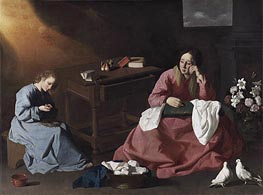
Christ and the Virgin in the House at Nazareth c.1635/40
Oil Painting
$2495
$2495
Canvas Print
$57.44
$57.44
SKU: ZUR-3225
Francisco de Zurbaran
Original Size: 165 x 218.2 cm
Cleveland Museum of Art, Ohio, USA
Francisco de Zurbaran
Original Size: 165 x 218.2 cm
Cleveland Museum of Art, Ohio, USA
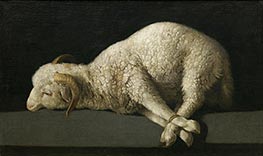
Agnus Dei c.1635/40
Oil Painting
$1137
$1137
Canvas Print
$50.59
$50.59
SKU: ZUR-4839
Francisco de Zurbaran
Original Size: 37.3 x 62 cm
Prado Museum, Madrid, Spain
Francisco de Zurbaran
Original Size: 37.3 x 62 cm
Prado Museum, Madrid, Spain
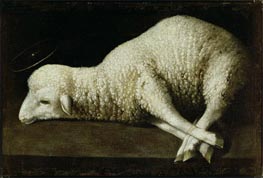
Agnus Dei c.1636/40
Oil Painting
$1119
$1119
Canvas Print
$50.59
$50.59
SKU: ZUR-4840
Francisco de Zurbaran
Original Size: 35.6 x 52 cm
San Diego Museum of Art, California, USA
Francisco de Zurbaran
Original Size: 35.6 x 52 cm
San Diego Museum of Art, California, USA
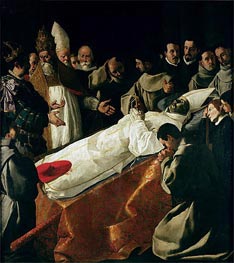
The Exhibition of the Body of St. Bonaventure a.1627
Canvas Print
$83.81
$83.81
SKU: ZUR-7793
Francisco de Zurbaran
Original Size: 245 x 220 cm
Louvre Museum, Paris, France
Francisco de Zurbaran
Original Size: 245 x 220 cm
Louvre Museum, Paris, France
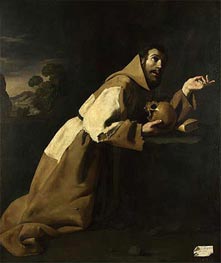
St. Francis in Meditation 1639
Oil Painting
$1322
$1322
Canvas Print
$107.26
$107.26
SKU: ZUR-7794
Francisco de Zurbaran
Original Size: 162 x 137 cm
National Gallery, London, United Kingdom
Francisco de Zurbaran
Original Size: 162 x 137 cm
National Gallery, London, United Kingdom
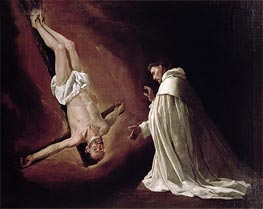
Appearance of St. Peter to St. Peter Nolasco 1629
Oil Painting
$1755
$1755
Canvas Print
$82.87
$82.87
SKU: ZUR-7795
Francisco de Zurbaran
Original Size: 179 x 223 cm
Prado Museum, Madrid, Spain
Francisco de Zurbaran
Original Size: 179 x 223 cm
Prado Museum, Madrid, Spain
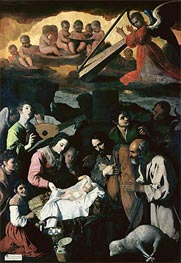
Adoration of the Shepherds 1638
Canvas Print
$75.95
$75.95
SKU: ZUR-7796
Francisco de Zurbaran
Original Size: unknown
Musee des Beaux Arts, Grenoble, France
Francisco de Zurbaran
Original Size: unknown
Musee des Beaux Arts, Grenoble, France
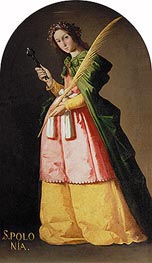
St. Apollonia c.1636
Oil Painting
$1478
$1478
Canvas Print
$50.59
$50.59
SKU: ZUR-7797
Francisco de Zurbaran
Original Size: 134 x 67 cm
Louvre Museum, Paris, France
Francisco de Zurbaran
Original Size: 134 x 67 cm
Louvre Museum, Paris, France
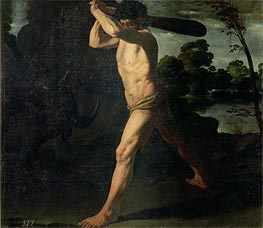
Hercules and the Cretan Bull 1634
Oil Painting
$1170
$1170
Canvas Print
$66.51
$66.51
SKU: ZUR-7798
Francisco de Zurbaran
Original Size: unknown
Prado Museum, Madrid, Spain
Francisco de Zurbaran
Original Size: unknown
Prado Museum, Madrid, Spain
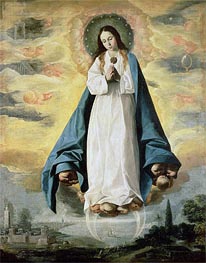
The Immaculate Conception n.d.
Oil Painting
$1793
$1793
Canvas Print
$86.83
$86.83
SKU: ZUR-7799
Francisco de Zurbaran
Original Size: unknown
Museo Diocesano de Siguenza, Guadalajara, Spain
Francisco de Zurbaran
Original Size: unknown
Museo Diocesano de Siguenza, Guadalajara, Spain
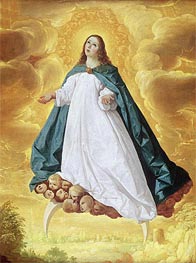
The Immaculate Conception c.1628/30
Oil Painting
$1814
$1814
Canvas Print
$82.15
$82.15
SKU: ZUR-7800
Francisco de Zurbaran
Original Size: 101 x 76 cm
Private Collection
Francisco de Zurbaran
Original Size: 101 x 76 cm
Private Collection
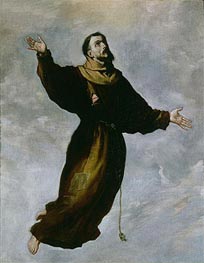
Levitation of St. Francis n.d.
Oil Painting
$1517
$1517
Canvas Print
$73.29
$73.29
SKU: ZUR-7801
Francisco de Zurbaran
Original Size: 100 x 81.6 cm
Bowes Museum, County Durham, United Kingdom
Francisco de Zurbaran
Original Size: 100 x 81.6 cm
Bowes Museum, County Durham, United Kingdom
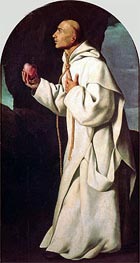
Portrait of the Devout John Houghton c.1637/39
Oil Painting
$1369
$1369
Canvas Print
$50.59
$50.59
SKU: ZUR-7802
Francisco de Zurbaran
Original Size: 122 x 64 cm
Museo de Cadiz, Cadiz, Spain
Francisco de Zurbaran
Original Size: 122 x 64 cm
Museo de Cadiz, Cadiz, Spain
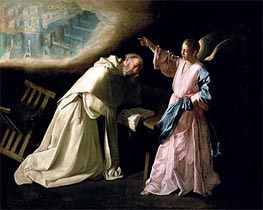
Vision of St. Peter Nolasco 1629
Oil Painting
$2207
$2207
Canvas Print
$82.35
$82.35
SKU: ZUR-7803
Francisco de Zurbaran
Original Size: 179 x 223 cm
Prado Museum, Madrid, Spain
Francisco de Zurbaran
Original Size: 179 x 223 cm
Prado Museum, Madrid, Spain
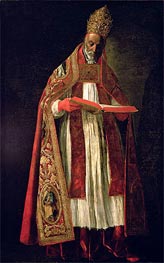
St. Gregory the Great n.d.
Oil Painting
$2125
$2125
Canvas Print
$58.91
$58.91
SKU: ZUR-7804
Francisco de Zurbaran
Original Size: 198 x 125 cm
Museo de Bellas Artes, Seville, Spain
Francisco de Zurbaran
Original Size: 198 x 125 cm
Museo de Bellas Artes, Seville, Spain
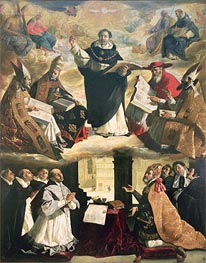
The Apotheosis of St. Thomas Aquinas 1631
Canvas Print
$74.07
$74.07
SKU: ZUR-7805
Francisco de Zurbaran
Original Size: 486 x 385 cm
Museo de Bellas Artes, Seville, Spain
Francisco de Zurbaran
Original Size: 486 x 385 cm
Museo de Bellas Artes, Seville, Spain
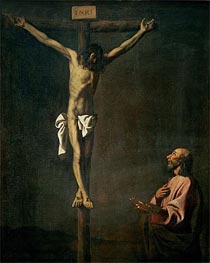
St. Luke as a Painter before Christ on the Cross c.1660
Oil Painting
$1561
$1561
Canvas Print
$88.33
$88.33
SKU: ZUR-7806
Francisco de Zurbaran
Original Size: 108 x 84 cm
Prado Museum, Madrid, Spain
Francisco de Zurbaran
Original Size: 108 x 84 cm
Prado Museum, Madrid, Spain
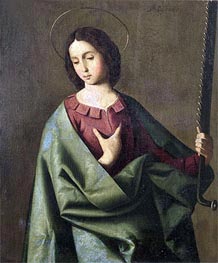
St. Euphemia n.d.
Oil Painting
$1409
$1409
Canvas Print
$78.39
$78.39
SKU: ZUR-7807
Francisco de Zurbaran
Original Size: unknown
Prado Museum, Madrid, Spain
Francisco de Zurbaran
Original Size: unknown
Prado Museum, Madrid, Spain
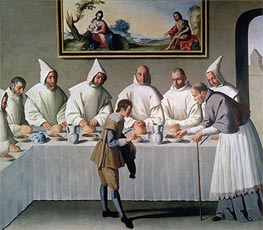
St. Hugh of Cluny in the Refectory of the Carthusians 1633
Canvas Print
$75.37
$75.37
SKU: ZUR-7808
Francisco de Zurbaran
Original Size: 262 x 307 cm
Museo de Bellas Artes, Seville, Spain
Francisco de Zurbaran
Original Size: 262 x 307 cm
Museo de Bellas Artes, Seville, Spain
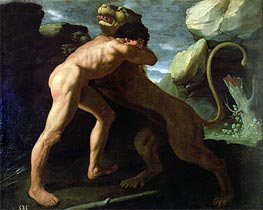
Hercules Fighting with the Nemean Lion n.d.
Oil Painting
$1633
$1633
Canvas Print
$82.35
$82.35
SKU: ZUR-7809
Francisco de Zurbaran
Original Size: unknown
Prado Museum, Madrid, Spain
Francisco de Zurbaran
Original Size: unknown
Prado Museum, Madrid, Spain
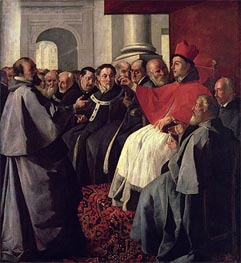
St. Bonaventure at the Council of Lyons in 1274 1627
Canvas Print
$86.44
$86.44
SKU: ZUR-7810
Francisco de Zurbaran
Original Size: 250 x 225 cm
Louvre Museum, Paris, France
Francisco de Zurbaran
Original Size: 250 x 225 cm
Louvre Museum, Paris, France
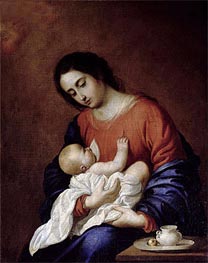
Virgin and Child 1658
Oil Painting
$1493
$1493
Canvas Print
$60.65
$60.65
SKU: ZUR-7811
Francisco de Zurbaran
Original Size: 101 x 78 cm
Pushkin Museum of Fine Arts, Moscow, Russia
Francisco de Zurbaran
Original Size: 101 x 78 cm
Pushkin Museum of Fine Arts, Moscow, Russia